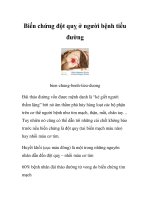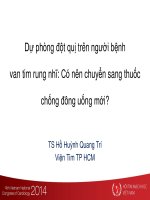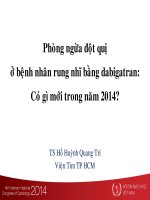Dự phòng đột quỵ ở người rung nhĩ chuẩn mực cũ, phát triển mới và tương lai
Bạn đang xem bản rút gọn của tài liệu. Xem và tải ngay bản đầy đủ của tài liệu tại đây (2.02 MB, 31 trang )
Stroke Prevention in Atrial Fibrillation
Old Standards, New Developments, and
the Future
Michael Rinaldi, MD
The Sanger Heart and Vascular Institute
Carolinas HealthCare System
Charlotte NC USA
Disclosures
Consultant:
Abbott Vascular
Boston Scientific
St. Jude Medical
The AF Epidemic
Projected Number of Adults With Atrial Fibrillation in the United States Between 1995 and
2050
Projected Number of Adults with Atrial Fibrillation in the United States
Extrapolation of Kaiser Permanente data
Go, A. S. et al. JAMA 2001;285:2370-2375.
Copyright restrictions may apply.
AF is a Major Cause of Stroke
LAA source of embolic stroke in 90%
Assessment of Thromboembolic Risk
CHA2DS2-VASc
CHF/ LV dysfunction
Hypertension
Age 75 years
Diabetes mellitus
Stroke/TIA/TE
Vascular disease
(CAD, AoD, PAD)
Age 65–74 years
Sex category (female)
1
1
2
1
2
1
1
1
Score 0–9
1.
2.
Lip GY, et al. Chest 2010;137(2):263–272
Olesen JB, et al. BMJ 2011;342:d124
Stroke Prevention: Pharmacologic Options
Stroke or systemic embolism
Relative Hazard Ratio
(95% CI)
Category
Intracranial haemorrhage
W vs Dabigatran 110
W vs Placebo
W vs Rivaroxaban
W vs Wlow dose
W vs Dabigatran 150
W vs Aspirin
W vs Apixaban 5
W vs Aspirin + Clop
0
0.3 0.6 0.9 1.2 1.5 1.8 2.0
W vs Ximelagatran
Major bleeding
W vs Dabigatran 110
W vs Rivaroxaban
W vs Dabigatran 110
W vs Dabigatran 150
W vs Rivaroxaban
W vs Apixaban 5
W vs Dabigatran 150
0
0.3 0.6 0.9 1.2 1.5 1.8 2.0
Favours
Favours other Rx
warfarin
W vs Apixaban 5
0
0.3 0.6 0.9 1.2 1.5 1.8 2.0
Favours
Favours other Rx
warfarin
Modified from Camm A.J. EHJ 2009;30:2554-5
Bleeding Risk Prediction with Oral AC
HAS-BLED Score
Score
Bleeds per
100 pt-yrs
0
1.13
1
1.02
2
1.88
3
3.74
4
8.70
New Oral AC Drugs vs. Warfarin
Study
RE-LY1
Treatment
Major Bleeding
Hemorrhagic
Stroke
Dabigatran (110 mg)
2.71%
0.12%
Dabigatran (150 mg)
3.11%
0.10%
Warfarin
3.36%
0.38%
Rivaroxaban
3.6%
0.5%
Warfarin
3.4%
0.7%
Apixaban
2.13%
0.24%
Warfarin
3.09%
0.47%
ROCKET-AF2
ARISTOTLE3
Non Pharmacologic Options for
Stroke Prevention
AMPLATZER ™
Cardiac Plug
Percutaneous LAA Occlusion
Watchman Procedure
Femoral venous access
Trans-septal sheath
TEE and flouroscopic guidance
LAA is a highly variable structure
Must be measure accurately with TEE to assess
suitability for closure
TEE Guided Trans-septal: Bicaval and SAX-B
LAA is a Complex Variable Structure
Sheath is inserted into a LAA lobe
Guide positioned by markers and device is deployed
First deployment suboptimal
High shoulder suggests poor anchoring
A more superior lobe is selected and guice is positioned
Compare new position (left) with first position (right)
Watchman is deployed and Tug Test
performed to assure stability
First deployment
canted and less stable
Second deployment
more coaxial and stable
The Watchman Device
PROTECT-AF:Overview
Randomized FDA-IDE Trial
Can the WATCHMAN device
replace Warfarin?
Non-Valvular AF
CHADs ≥ 1
Efficacy Endpoint:
Stroke
CV death (& Unknown)
Systemic embolism
Randomization (1:2)
Safety Endpoint
Non-inferiority & Superiority
Bayesian Sequential Design
Analysis at 600 pt-yrs & every 150
pt-yrs thereafter 1500 pt-yr
Follow-up till 5 years
Warfarin
Watchman
Follow-Up
Patient Study Timeline
PostImplant
Day 0
Day 45
Day 180
Ongoing
WATCHMAN
Day 2-14
Pre-implant interval
Patient gets WATCHMAN
Patient takes Warfarin
Patient discontinues Warfarin / takes Clopidogrel
Patient discontinues Clopidogrel
Control
Randomize
Control patient takes Warfarin
Day 0
Ongoing
Vascular Complications
7 Day Serious Procedure/Device Related
Composite of vascular complications includes cardiac perforation, pericardial effusion
with tamponade, ischemic stroke, device embolization, and other vascular
complications1
10.0%
p = 0.005
8.7%
% of Patients
8.0%
6.0%
4.0%
2.0%
n=39
4.1%
4.4%
n=23
n=12
0.0%
PROTECT AF
CAP
PREVAIL
No procedure-related deaths reported in any of the trials
PROTECT AF Long Term (4 Year Follow-up)
Rate per 100 patient years
Events in PROTECT AF trial at 2,621 patient years
10
9
8
7
6
5
4
3
2
1
0
34% lower
60% lower
40% lower
P=0.0379
P=0.0045
PS = 0.96
4.8
3.8
3.2
2.4
2.3
1.0
Primary Efficacy
CV or
Unexplained Death
WATCHMAN Group
N=463
All-Cause Death
Warfarin Group
N=244
Ps = Posterior Probability for Superiority
All three endpoints met statistical superiority
Protect AF and Prevail Pooled Analysis









